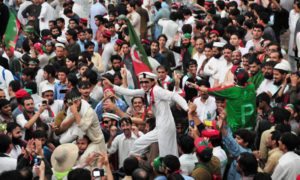Political financing in Pakistan does not seem to have a ceiling as we see the political parties spending millions of rupees on their events. However, as a prevalent practice, the source of this huge amount of money remains undisclosed.
Lately all public political meetings have been composed of music, dancing and other shenanigans that would rather describe these meetings as carnivals. A significant number of people also watch these ‘jalsas’ at home on their TVs.
Interestingly, nobody actually knows how much do these public meetings cost and what things are required to host such meetings. A number of people attending these jalsas and voting for those on the stage were asked to guess the actual figures of the cost spent by those they were voting for, and no one was even close to guessing the overall budget.
Also Read: Tariq Afridi – The cartoonist at the cross of craft
Different parties and their oppositions keep accusing each other of using the money of the general public to host their political activities. However, the issue has been taken lightly by authorities and is not being given the attention it deserves.
Officials from Islamabad have also stated that political parties have not been clear about the total budget of their events and meetings. Moreover, they show less than what they actually spend. It was also informed that there exists a political finance cell which is currently dysfunctional.
According to a report, the ECP Director General (Law) Muhammad Arshad said:
“An opinion on any legislation on political financing has never been sought during my tenure”
The FBR, which measures the income and expenditures of individuals and organizations for the purpose of taxation, said that it is only an implementing body. Moreover, they also said that their legal taxation framework on political parties and their financial conduct is plain and straightforward.
Quick Read: Corrupt politicians? Only 21% employees of top 24 companies pay their taxes
However, the FBR couldn’t provide an answer to why it didn’t issue legal notices to political parties for not filing annual income tax returns in a system where even NGOs and CBOs are not given relief. Moreover, the FBR has been happy that the proposal for a blanket tax exemption for political parties in the Finance Bill 2017 was disregarded by the parliament. A member of the FBR said,
“It would have created another loophole for tax evaders”
Rs5 Million for A public meeting
In a report shared by a local newspaper, political activists were reached out to in order to get information about how much money is spent on their events but they weren’t much cooperative. However, information about transporters, caterers, event managers, and decoration service providers gave a rough estimate of the event cost. After some digging in the whole matter through political activists of different parties, the budget for public meetings has been estimated.
For an average public meeting during day time with complete sound system, security, transport, stage, and seating arrangement for 5000 people, the cost is whopping Rs5 million. Moreover, the price doubles if food is also served and increases more if the event is scheduled at night time – which happens to be the normal practice in Pakistan of late.
Read More: Another scandal? Planning Commission provides false development spending record
Budget analysis
If the budget of a daytime jalsa is broken down for analysis, security and sound system alone cost one third of the total budget whereas 20% of the cost is covered by electronics which includes LCDs and back-up generators when the meeting is held at night.
The PML-N is most liked by the vendors as the party spends more and is always first to settle the dues. PTI is considered a little lazy in this manner as the party is a little slow in making the payments. However, PPP has quite a bad reputation in this field.
Vendors also told that the bigger the meeting, the more likely it is for the cost per participant to fall down. However, public meetings in small towns and villages cost more due to transport and food costs. Political activist from Punjab said:
“Villagers expect a feast in a jalsa and parties can’t afford to disappoint the potential voters in a fiercely competing environment in an election year”
Talking about the budget for advertising, an executive of the advertising agency said:
“Cost drivers are easy to identify but the income of parties and details of their key financiers are hidden. As the dealings are mostly cash-based, the verification of source is very difficult. The funding by powerful business lobbies is shielded by several layers of veils”
The current political expenditure system is going down as funding from illegitimate sources is increasing, said a lawyer. He also said that:
“Effective politicking is an expensive business. There is a need to evolve a legal framework that corresponds to demands of time and incentivizes disclosure and transparency”
Also Read: Ishaq Dar – Is it time to say goodbye?
An analyst added that:
“The collective annual spending by competing political parties runs in billions, but a system to gauge, monitor and audit accounts or tax huge income has yet to evolve”
Senior FBR officials stated that:
“Parliament should amend laws to make the filing of returns by political parties mandatory, as is the case in democracies around the world.”


